-
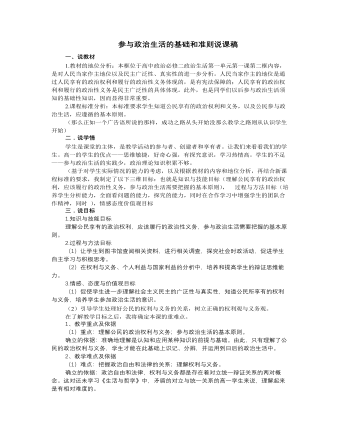
人教版高中政治必修2参与政治生活的基础和准则说课稿
观点一:没有无义务的权利,也没有无权利的义务;观点二权利与义务是完全对等的。根据学生的回答,教师点拨归纳,一般来说,权利与义务是对等的,因为没有义务的权利只能是特权,而没有权利的义务只能是奴役,只有将权利与义务有机结合起来,才能构成一个符合社会发展要求的公民社会,在讨论和思考中,使学生树立正确的观点,引导学生多方面、多角度地辩证认识权利与义务的关系。(3)个人利益和国家利益相结合的原则。引出汶川大地震中一些先进人物事迹,但另外也有一些人发国难财的人,如黑心棉事件等,针对上述材料,请同学们谈谈自己的看法。引导学生理解国家和公民个人利益在根本上是一致的,当个人利益与国家利益发生矛盾时,个人利益要服从国家利益。通过案例分析,培养学生获取信息的能力,自主学习的能力以及全面看问题的能力,再结合教师的讲授,给学生一种茅塞顿开的感觉。
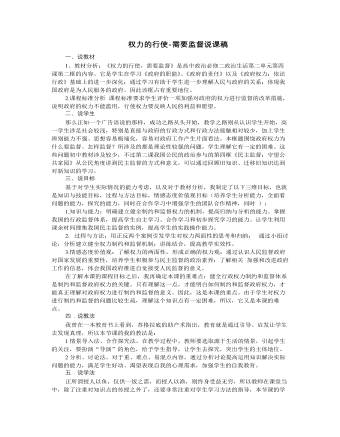
人教版高中政治必修2权力的行使-需要监督说课稿
环节四 情景回归 参与体验(教学内容:为政务公开喝彩)探究问题:什么是政务公开,目的何在,有何意义?我将引导学生,想想我省的政务公开开展的如何呢?怎样才能了解到这些内容呢?这样,通过联系本省的在增强政府工作透明度方面的做法,在进行知识教育的同时,拉近了学生与政治生活的距离,增强了学生参与民主监督的意识和能力。同时也可以把其他相关的网站如市政府门户网站介绍给大家,我国各级政府建立了信息公开制度和办事公开制度;然后,我将让学生们思考实施政务公开有什么意义?对于其意义同样是让学生根据其特点进行概括,达到方法的训练和能力的提升。环节五 课堂小结 巩固知识本节课我采用线索性的板书,整个知识结构一目了然,为了充分发挥学生在课堂的主体地位,我将课堂小结交由学生完成,请学生根据课堂学习的内容,结合我的板书设计来进行小结,以此来帮助教师在第一时间掌握学生学习信息的反馈,同时培养学生归纳分析能力、概括能力。
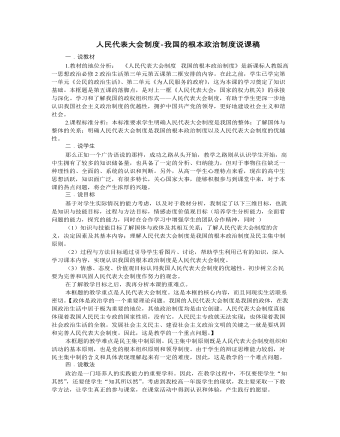
人教版高中政治必修2人民代表大会制度-我国的根本政治制度说课稿
材料四:两会结束后,全国人大常委会办公厅将召开代表建议交办会,将这些建议统一交由国务院有关部委、最高人民法院、最高人民检察院等180个机关、单位办理。】通过分组讨论,请学生回答问题,我将做相应的点拨和补充:在人民代表大会与人民的关系上,从产生看,人民代表大会的代表由民主选举产生,对人民负责,受人民监督;从过程看,在人民代表大会的活动中,法律的制定和重大问题的决策,由人民代表充分讨论,实行少数服从多数原则,民主决定;在人民代表大会与其他国家机关的关系上,人大是国家权力机关,国家行政机关、审判机关、检察机关都由它产生,对它负责,受它监督。人大统一行使国家权力,它所决定的事情不是自己直接去办,是由国家行政和司法等机关去贯彻执行。请同学们根据刚所学的知识,将民主集中制原则的具体体现,用表格形式进行归纳总结,培养了学生归纳分析能了和独立思考的能力。
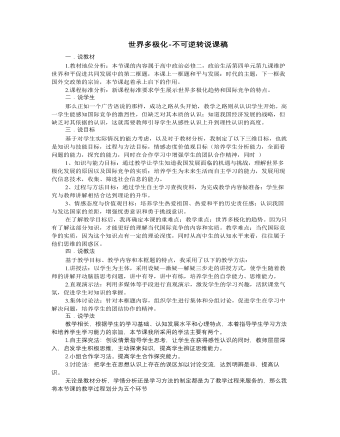
人教版高中政治必修2世界多极化-不可逆转说课稿
环节四 课堂小结 巩固知识 本节课我采用线索性的板书,整个知识结构一目了然,为了充分发挥学生在课堂的主体地位,我将课堂小结交由学生完成,请学生根据课堂学习的内容,结合我的板书设计来进行小结,以此来帮助教师在第一时间掌握学生学习信息的反馈,同时培养学生归纳分析能力、概括能力。环节五 情景回归,情感升华我的实习指导老师告诉过我们,政治这一门学科要从生活中来到生活去,所以在课堂的最后布置课外作业,以此培养学生对理论的实际运用能力,同时检验他们对知识的真正掌握情况,以此达到情感的升华,本节课,我根据建构主义理论,强调学生是学习的中心,学生是知识意义的主动建构者,是信息加工的主体,要强调学生在课堂中的参与性、以及探究性,不仅让他们懂得知识,更让他们相信知识,并且将知识融入到实践当中去,最终达到知、情、意、行的统一。
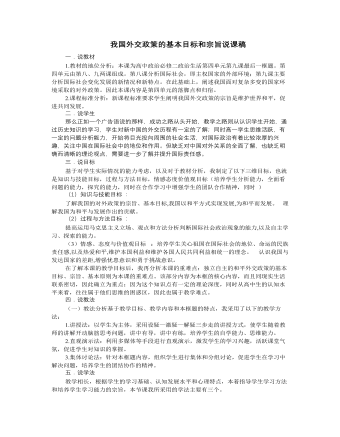
人教版高中政治必修2我国外交政策的基本目标和宗旨说课稿
环节四 课堂小结 巩固知识本节课我采用线索性的板书,整个知识结构一目了然,为了充分发挥学生在课堂的主体地位,我将课堂小结交由学生完成,请学生根据课堂学习的内容,结合我的板书设计来进行小结,以此来帮助教师在第一时间掌握学生学习信息的反馈,同时培养学生归纳分析能力、概括能力。环节五 情景回归,情感升华我的实习指导老师告诉过我们,政治这一门学科要从生活中来到生活去,所以在课堂的最后布置课外作业,以此培养学生对理论的实际运用能力,同时检验他们对知识的真正掌握情况,以此达到情感的升华,本节课,我根据建构主义理论,强调学生是学习的中心,学生是知识意义的主动建构者,是信息加工的主体,要强调学生在课堂中的参与性、以及探究性,不仅让他们懂得知识,更让他们相信知识,并且将知识融入到实践当中去,最终达到知、情、意、行的统一。
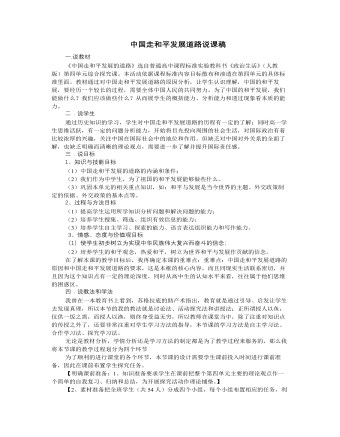
人教版高中政治必修2中国走和平发展道路说课稿
教师点评:根据小论文的写作情况对小论文给予肯定,同时指出其有待修改的地方。学生在写小论文的时候是根据教材中的提示来写的,所以对于教材中的这些提示,可以作一个说明。如“在发展的过程中,我们面对怎样的挑战和困难”,对于这点,学生可能会出现片面看问题的不足,一旦这种情况出现,我们就要及时进行说明:我们面临的挑战和困难既有来自国内的,也有来自国际的,引导学生学会用全面的观点分析问题。教师引导学生明确作为中学生可以从以下方面去作准备:第一,要有国家观念、民族意识,不断增强民族自豪感、自尊心和自信心;第二,关注国家大事;第三,自自觉履行维护国家统一和民族团结的义务,维护国家安全、荣誉和利益;第四,努力学好科学文化知识,提高自己的科学文化素质和思想道德素质,增强各个方面的能力,掌握振兴中华民族的本领,这也是中学生最需要做到的。通过探究活动,培养学生获取信息的能力,自主学习的能力以及全面看问题的能力,再结合教师的讲授,给学生一种茅塞顿开的感觉。
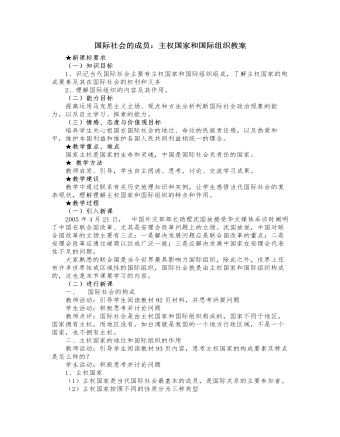
人教版高中政治必修2国际社会的成员:主权国家和国际组织教案
(1)1945.10.24日,《联合国宪章》生效,联合国正式成立。主要机构有:联合国大会、安全理事会、经济及社会理事会、托管理事会、国际法院、秘书处等。(2)联合国的宗旨:维护国际和平与安全;发展国际间以尊重人民平等权利及自决原则为基础的友好关系;促进国际合作,以解决国际间属于经济、社会、文化及人类福利性质的国际问题;作为协调各国活动的中心。简单地说,就是维护国际和平与安全,促进国际合作与发展。(3)联合国的原则:各会员国主权平等,履行宪章规定的义务,以和平方式解决国际争端,不得对其他国家进行武力威胁或使用武力,集体协作,不干涉任何国家的内政,确保非会员国遵守上述原则。(4)联合国的作用:联合国在维护世界和平与安全,促进经济、社会的发展,以及实行人道主义援助等方面发挥着积极作用。
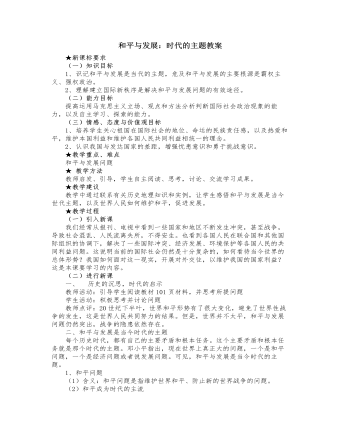
人教版高中政治必修2和平与发展:时代的主题教案
2、建立国际新秩序(1)建立国际新秩序是解决和平与发展问题的有效途径为了和平与发展,必须改变旧的国际秩序,建立以和平共处五项原则为基础的有利于世界和平与发展的国际新秩序。这是抑制霸权主义、强权政治,解决和平与发展问题的有效途径,是每个国家生存和发展的最基本和最重要的外部条件。教师活动:引导学生阅读教材103页“相关链接”材料,并思考所反映的问题学生活动:积极思考并讨论问题教师点评:世界发展的主体是世界各国人民。世界的管理必须由各国人民共同参与。这是各国人民的共同呼声。(2)国际政治经济新秩序的主要内容建立国际政治经济新秩序,就是要保障各国享有主权平等和内政不受干涉的权利,保障各国享有平等参与国际事务的权利,保障各国特别是广大发展中国家享有平等的发展权利,保障各个民族和各种文明共同发展的权利。
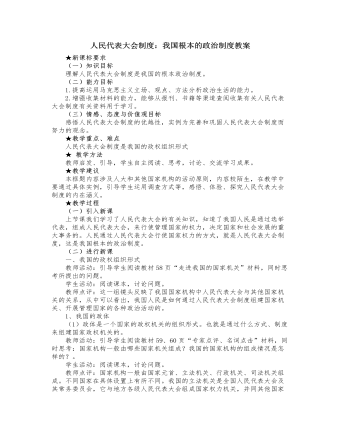
人教版高中政治必修2人民代表大会制度:我国根本的政治制度教案
二、适合我国国情的根本政治制度1、人民代表大会制度的主要内容国家的一切权力属于人民;人民在普选的基础上选举代表,组成各级人民代表大会作为国家权力机关;由国家权力机关产生其他国家机关,依法行使各自的职权;实行民主集中制的组织和活动原则等。2、为什么说人民代表大会制度是适合我国国情的根本政治制度(1)人民代表大会制度是由人民民主专政的社会主义国家性质决定的,是建立其他国家管理制度的基础,是中国社会主义民主政治最鲜明的特点。(2)人民代表大会制度以人民当家作主为宗旨,真正保证了人民群众参加国家管理,充分体现了人民的意志和利益。(3)实践证明,我国人民民主专政的国体和人民代表大会制度的政体,是中国人民奋斗的成果和历史的选择,是适合我国国情的政治制度。(4)建设社会主义民主政治,最重要的是坚持和完善人民代表大会制度,决不照搬西方的政治制度模式。
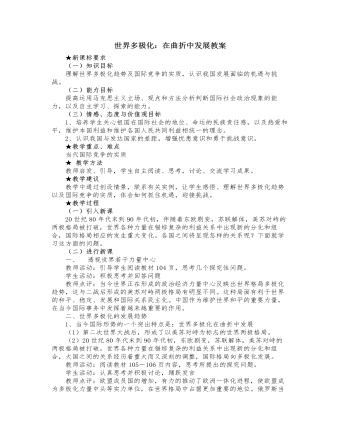
人教版高中政治必修2世界多极化:在曲折中发展教案
教师点评:综合国力是指一个主权国家生存和发展所拥有的全部实力(即物质力和精神力)及国际影响力的合力。经济实力、科技实力、国防实力,这些物质力量是基础。其中,经济力和科技力已经成为决定性的因素。文化、经济、政治实力在综合国力竞争中越来越突出,民族精神、民族凝聚力是综合国力的重要组成部分。教师活动:阅读教材第106页“相关链接”内容,了解各国是如何展开竞争的?学生活动:认真思考并踊跃发言教师点评:当今世界,发展经济和科学技术是世界大多数国家关心的问题,各国之间的竞争也越来越多地转向经济和科技领域。世界多数国家都以发展经济和科技作为国家的战略重点,制定发展战略,努力增强自己的综合国力,力图在世界格局中占据有利地位。2、加快发展,增强我国的综合国力教师活动:阅读教材第107页图表,并思考所提出的问题。
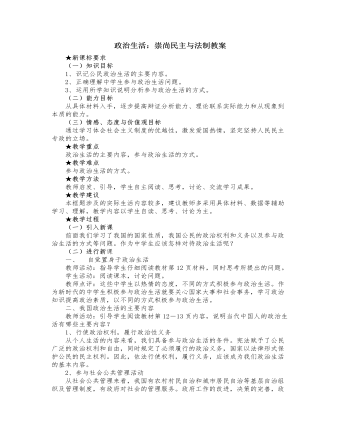
人教版高中政治必修2政治生活:崇尚民主与法制教案
2、学习有关政治知识学习政治知识有助于提高辨别是非能力,坚持正确政治方向;有助于紧扣时代脉搏,开阔眼界;有助于树立国家观念,维护国家利益;有助于增强民主法制观念培养公民意识;有助于提高参与政治生活的能力。3、参与政治生活,贵在实践教师活动:同学们参加过什么政治活动?你还知道有哪些可以参与的政治活动?学生活动:积极思考。我国公民参与政治生活的方式多种多样,无论什么方式,重要的是参与,在实践中才能才能不断提高自己的政治素质和参与政治生活的能力。(三)课堂总结、点评本节内容讲述了我国的政治生活的主要内容和中学生参与政治生活的方式、途径,这对我们今后提高自身政治素质,增强参与政治生活的能力等,证明了奋斗方向。
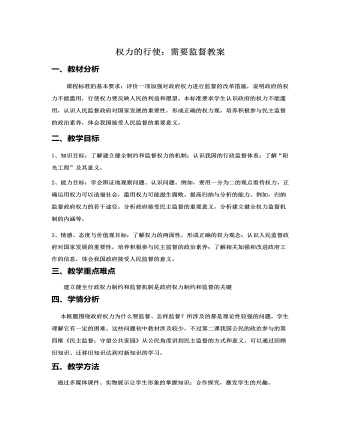
人教版高中政治必修2权力的行使:需要监督教案
一、教材分析课程标准的基本要求:评价一项加强对政府权力进行监督的改革措施,说明政府的权力不能滥用,行使权力要反映人民的利益和愿望。本标准要求学生认识政府的权力不能滥用,认识人民监督政府对国家发展的重要性,形成正确的权力观,培养积极参与民主监督的政治素养,体会我国接受人民监督的重要意义。二、教学目标1、知识目标:了解建立健全制约和监督权力的机制;认识我国的行政监督体系;了解“阳光工程”及其意义。2、能力目标:学会辨证地观察问题、认识问题。例如,要用一分为二的观点看待权力,正确运用权力可以造福社会,滥用权力可能滋生腐败。提高归纳与分析的能力。例如,归纳监督政府权力的若干途径。分析政府接受民主监督的重要意义,分析建立健全权力监督机制的内涵等。
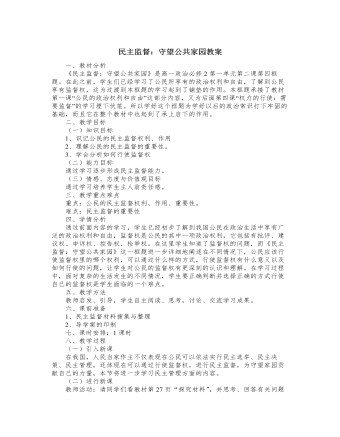
人教版高中政治必修2民主监督:守望公共家园教案
一、教材分析《民主监督:守望公共家园》是高一政治必修2第一单元第二课第四框题。在此之前,学生们已经学习了公民所享有的政治权利和自由,了解到公民享有监督权,这为过渡到本框题的学习起到了铺垫的作用。本框题承接了教材第一课“公民的政治权利和自由”这部分内容,又为后面第四课“权力的行使:需要监督”的学习埋下伏笔。所以学好这个框题为学好以后的政治常识打下牢固的基础,而且它在整个教材中也起到了承上启下的作用。二、教学目标(一)知识目标1、识记公民的民主监督权利、作用2、理解公民的民主监督的重要性。3、学会分析如何行使监督权(二)能力目标通过学习逐步形成民主监督能力。(三)情感、态度与价值观目标通过学习培养学生主人翁责任感。三、教学重点难点重点:公民的民主监督权利、作用、重要性。难点:民主监督的重要性

人教版高中政治必修2人民代表大会制度:我国根本的政治制度教案
(三)合作探究、精讲点拨一、我国的政权组织形式教师活动:引导学生阅读教材58页“走进我国的国家机关”材料,同时思考所提出的问题。学生活动:阅读课本,讨论问题。教师点评:这一组镜头反映了我国国家机构中人民代表大会与其他国家机关的关系,从中可以看出,我国人民是如何通过人民代表大会制度组建国家机关、开展管理国家的各种政治活动的。1、我国的政体(1)政体是一个国家的政权机关的组织形式。也就是通过什么方式、制度来组建国家政权机关的。教师活动:引导学生阅读教材59、60页“专家点评、名词点击”材料,同时思考:国家机构一般由哪些国家机关组成?我国的国家机构的组成情况是怎样的?。学生活动:阅读课本,讨论问题。教师点评:国家机构一般由国家元首、立法机关、行政机关、司法机关组成。不同国家在具体设置上有所不同。我国的立法机关是全国人民代表大会及其常务委员会,它与地方各级人民代表大会组成国家权力机关,并同其他国家机关共同组成我国的国家机构体系。

新人教版高中英语必修3Unit 2 Morals and Virtues-Discovering Useful Structure教学设计
1. 表示时间。Hearing these stories, I’m skeptical about the place. = When I heard these stories. . . 2. 表示原因。Not knowing his address, I can’t send this book to him. = Because/Since/As I don’t know his address. . . 3. 表示结果。His father died, leaving him a lot of money. =. . . and left him a lot of money4. 表示条件。Going straight down the road, you will find the department store. = If you go straight down the road. . . 5. 表示让步。Being tired, they went on working. =Although they were tired. . . 6. 表示行为方式、伴随情况或补充说明。He lay on the grass, staring at the sky for a long time. =. . . and stared at the sky for a long time注意:非谓语动词作状语时, 如所提供的动词不能和句子中的主语保持一致, 动词-ing形式必须有自己的逻辑主语, 通常由名词或代词来担任, 这就是独立主格结构。The last bus having gone, we had to walk home. (having gone的逻辑主语是the last bus, 而不是we)Weather permitting, the football match will be played on Friday. (permitting的逻辑主语是time, 而不是the football match)Step 7 Practice1. ________(study) hard, you are sure to get first prize. 2. People use plastic in their daily life, _______(leave) large amounts of waste. 3. ________(work) hard at your lessons, you are to succeed. 4. The old man, ____________(work) abroad for twenty years, is on the way back to his motherland. 5. ______________(finish) his homework, he was playing on the playground. Answers: 1. Studying 2. leaving 3. Working 4.having worked 5. Having finishedStep 8 HomeworkFinish the homework on Page 22.
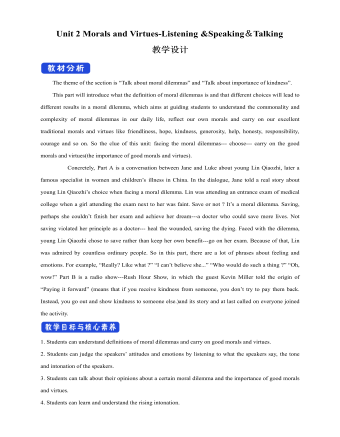
新人教版高中英语必修3Unit 2 Morals and Virtues-Listening &Speaking&Talking教学设计
Example:One day, a poor boy who was trying to pay his way through school by sending newspapers door to door found that he only had one dime(一角)left. He was so hungry that he decided to beg for a meal at the next house.However, he lost his nerve when a lovely young woman opened the door. Instead of a meal he asked for a drink of water. She thought he looked hungry so she brought him a large glass of milk. He drank it slowly, and then asked, “How much do I owe you?” “You don’t owe me anything,” she replied, “Mother has taught me never to accept pay for a kindness.” “Then I thank you from the bottom of my heart.” With these words, Howard Kelly left that house.Years later the woman became badly ill and was finally sent to the hospital in a big city. Dr. Howard Kelly, now famous, was called in. When he heard the name of the town she came from, a strange light filled his eyes. Dressed in his doctor’s clothes, Dr. Kelly went into her room and recognized her at once. From that day on, he gave special attention to her, and decided to do his best to save her life.At last the woman was saved. Dr. Kelly asked the business office to pass the final bill to him. He looked at it and then wrote something on the side. The bill was sent to the woman’s room. She was afraid to open it because she was sure that it would take the rest of her life to pay for it off. Finally she looked, and the note on the side of the bill caught her attention. She read these words: “Paid in full with a glass of milk, Dr. Howard Kelly.” Tear of joy flooded her eyes.

新人教版高中英语必修3Unit 2 Morals and Virtues-Reading and Thinking教学设计
The topic of this part is “Learn to make choices in life”.The Listening & Speaking & Talking part aims at the moral dilemmas, and this part is about making choices in life. The heroin is Lin Qiaozhi, a famous medical scientist, made a great contribution to our country’s medical care. Most importantly, her life experience can inspire our students whether in studying or the development of career. she had moral dilemmas and life choices, which are similar to the students who will step into society. Besides, Lin has quite good virtues like kindness, self-improvement, insistence, job-loving , generosity and responsibility, which is worth being learned.Concretely, this article is a biography about Lin Qiaozhi. The article tells her whole life according the timeline, among which the life choices is emphasized. For example, whether married or chased her dream, returned home or stayed abroad, family or public, her choices all reflected her faith, spirit, responsibility and devotion.1. Fast reading to get the detailed information about Lin Qiaozhi; careful reading to do the deductive information.2. Learn the reading skills--deductive judgement according the context.3. Study the structure features and language features. 4. Communicate about Lin’s life choices and reflect their own life choices.1. Learn the reading skills--deductive judgement according the context.2. Study the structure features and language features.3. Communicate about Lin’s life choices and reflect their own life choices.Step 1 Lead in---Small talkWhat are some important life choices?Importance choices: university study, jobs and marriage partners. Because they can determine our future.
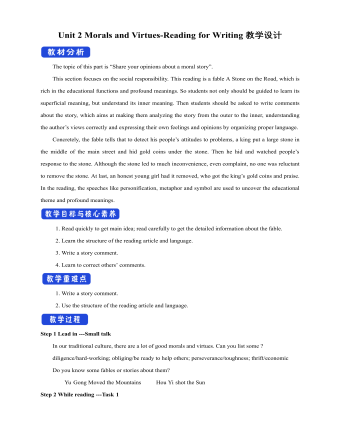
新人教版高中英语必修3Unit 2 Morals and Virtues-Reading for Writing教学设计
1. 这个寓言是一个关于一位国王古寓言。 The fable is an old fable about a king.2.作者用这个故事让读者对于社区的问题负有个人责任的必要印象深刻。The author used the story to impress upon readers with the need to take personal responsibility for problems in the community.3. 这个故事十分成功的实现了它的目的。The story was quite successful in achieving its purpose.Step 7 WritingPlease write a review of the story according the outline above.The fable is an old fable about a king who thought his people are lazy, so he put a large stone in the middle of the road and hides and waited to see if anyone will try to move it.The author used this story to impress upon readers with the need to take personal responsibility for problems in the community. The story was quite successful in achieving its purpose, and I liked it because it had a clear moral.However, while the moral of the story is clear, the actions of the king seemed pointless to me, because none of the characters in the story learnt anything. For this reason, I think there are better stories that can be used to impress upon people with the need for personal responsibility.Step 8 Pair workExchange drafts with a partner. Use this checklist to help your partner revise his/her draft.1. Does the writer give a short description of the story ?2. Does the description include the most important details of the story ?3. Does the writer give his or her opinion about the character or their actions ?4. Is the review well-organised ? 5. Does the writer use the -ing form as the adverbial correctly in the writing ?6. Are there any grammar, spelling, or punctuation errors ?Step 9 HomeworkPut up your revised draft in the classroom or read it to your class.
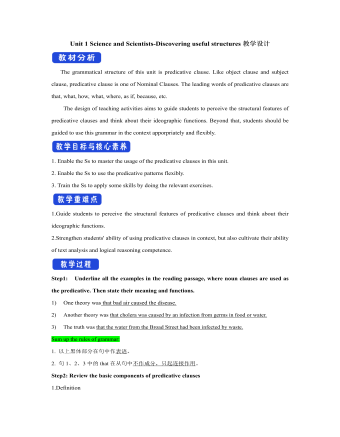
新人教版高中英语选修2Unit 1 Science and Scientists-Discovering useful structures教学设计
The grammatical structure of this unit is predicative clause. Like object clause and subject clause, predicative clause is one of Nominal Clauses. The leading words of predicative clauses are that, what, how, what, where, as if, because, etc.The design of teaching activities aims to guide students to perceive the structural features of predicative clauses and think about their ideographic functions. Beyond that, students should be guided to use this grammar in the context apporpriately and flexibly.1. Enable the Ss to master the usage of the predicative clauses in this unit.2. Enable the Ss to use the predicative patterns flexibly.3. Train the Ss to apply some skills by doing the relevant exercises.1.Guide students to perceive the structural features of predicative clauses and think about their ideographic functions.2.Strengthen students' ability of using predicative clauses in context, but also cultivate their ability of text analysis and logical reasoning competence.Step1: Underline all the examples in the reading passage, where noun clauses are used as the predicative. Then state their meaning and functions.1) One theory was that bad air caused the disease.2) Another theory was that cholera was caused by an infection from germs in food or water.3) The truth was that the water from the Broad Street had been infected by waste.Sum up the rules of grammar:1. 以上黑体部分在句中作表语。2. 句1、2、3中的that在从句中不作成分,只起连接作用。 Step2: Review the basic components of predicative clauses1.Definition
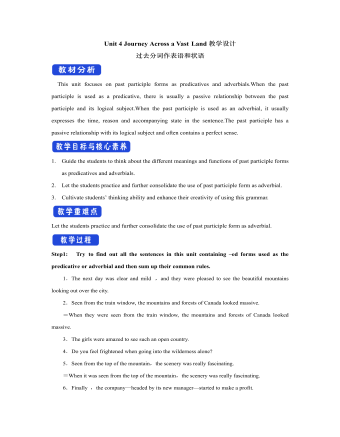
新人教版高中英语选修2Unit 4 Journey Across a Vast Land教学设计
当孩子们由父母陪同时,他们才被允许进入这个运动场。3.过去分词(短语)作状语时的几种特殊情况(1)过去分词(短语)在句中作时间、条件、原因、让步状语时,相当于对应的时间、条件、原因及让步状语从句。Seen from the top of the mountain (=When it is seen from the top of the mountain), the whole town looks more beautiful.从山顶上看,整个城市看起来更美了。Given ten more minutes (=If we are given ten more minutes), we will finish the work perfectly.如果多给十分钟,我们会完美地完成这项工作。Greatly touched by his words (=Because she was greatly touched by his words), she was full of tears.由于被他的话深深地感动,她满眼泪花。Warned of the storm (=Though they were warned of the storm), the farmers were still working on the farm.尽管被警告了风暴的到来,但农民们仍在农场干活。(2)过去分词(短语)在句中作伴随、方式等状语时,可改为句子的并列谓语或改为并列分句。The teacher came into the room, followed by two students (=and was followed by two students).后面跟着两个学生,老师走进了房间。He spent the whole afternoon, accompanied by his mom(=and was accompanied by his mom).他由母亲陪着度过了一整个下午。